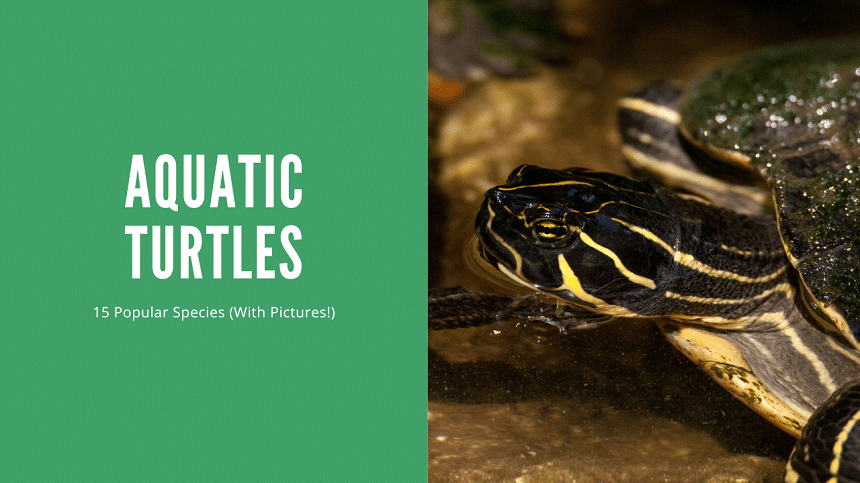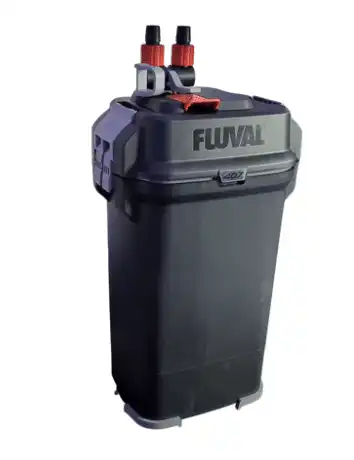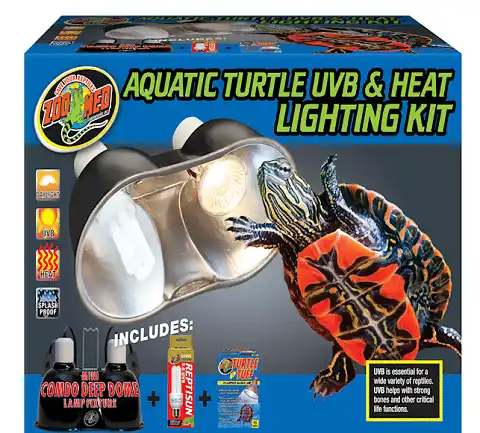Thank you for visiting! By the way… any links on this page that lead to products on Amazon and other stores/partners are affiliate links Aquarium Store Depot earns a commission if you make a purchase.
Are you considering a turtle as your next pet? These aquatic and semi-aquatic reptiles are fascinating and adorable creatures, but they do have some pretty specialized care requirements.
In this in-depth guide, we’ll introduce 15 of these amazing creatures, and learn more about how to care for them the right way. Read along to learn about their diet, habitat requirements, health precautions, conservation, and so much more.
Let’s get started!
Key Takeaways
- Aquatic turtles kept indoors need a temperature-controlled environment with access to a dry basking spot and UVB light.
- Turtles need plenty of swimming space and strong filtration system to keep their water quality high.
- Turtles can be pretty messy, so regular weekly water changes are important in aquariums and other small turtle tanks.
- Most turtles are omnivorous. Commercial turtle foods are a great staple diet, but your pet will love supplements like live insects and vegetables.
15 Popular Aquatic Turtle Species
Are you ready to dive in and learn about 15 awesome aquatic turtle species (check out the video above from our YouTube Channel)? Whether you’re a beginner looking for an adorable musk turtle or an experienced enthusiast hoping to keep an impressive snapping turtle, there’s something here for everyone!
Each species has different characteristics and care needs to stay healthy in captivity. That’s why I’ve included important stats like their temperament, diet requirements, tank size specifications, and other necessary information like ambient temperature and basking spot requirements.
1. African Sideneck
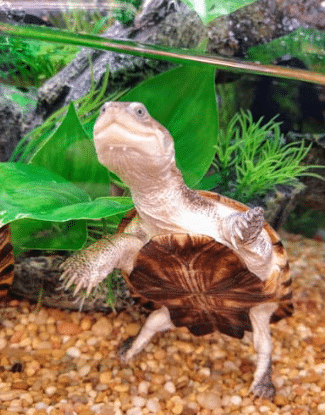
- Scientific Name: Pelusios spp.
- Common Names: West African mud turtle
- Family: Pelemodusidae
- Origin: Africa
- Diet: Omnivorous
- Care level: Moderate
- Lifespan: 25 to 50 years
- Temperament: Calm but shy
- Minimum Habitat Size: 100 gallons
- Ambient Temperature Range: 75 – 85 °F or 24 – 29°C
- Basking Spot: 95 °F or 35 °C
- Water Temperature: 75 – 80 °F or 24 – 27 °C
African sideneck turtles are one of the most adorable species in the hobby. These fascinating aquatic reptiles come from rivers, lakes, and ponds in Africa. Like false map turtles, these inquisitive creatures do not fully retract their heads into their shells.
The diet for this long-lived omnivorous species should include meaty foods like cooked chicken, beef heart, and fish, which can be supplemented occasionally with vegetables and fruit to provide a balanced diet.
2. Red Eared Slider
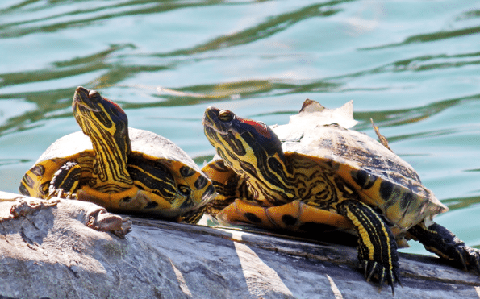
- Scientific Name: Trachemys scripta elegans
- Common Names: Red-eared terrapin
- Family: Emydidae
- Origin: Southeast USA
- Diet: Omnivore
- Care level: Moderate
- Lifespan: 20 – 40 years
- Temperament: Does not enjoy handling
- Minimum Habitat Size: 50+ gallons
- Ambient Temperature Range: 70 – 85 °F or 21 – 29 °C
- Basking Spot: 85 – 90 °F or 29 – 32 °C
- Water Temperature: 75 – 85 °F or 24 – 29 °C
The Red Eared Slider is widespread in the southeast of the United States and has become one the most popular pet turtle species. These social creatures need plenty of space, UV lighting, and a quality water filtration system in their habitat to live to their full potential lifespan.
They are omnivorous creatures that will thrive on a balanced diet of commercial turtle foods supplemented with vegetables and meaty foods like crickets and minnows. You could keep a young pair in a tank of thirty gallons or so but the minimum tank size for two adults would be about 100 gallons, along with enough basking sites.
3. Caspian Pond

- Scientific Name: Mauremys caspica
- Common Names: Caspian turtle
- Family: Geoemydidae
- Origin: Mediterranean, Middle-east, Russia
- Diet: Omnivore
- Care level: Easy
- Lifespan: 20 – 40+ years
- Temperament: Peaceful but does not enjoy being handled
- Minimum Habitat Size: 50 gallons for a single specimen
- Ambient Temperature Range: 60 – 80 °F or 16 – 27 °C
- Basking Spot: 100 °F or 37 °C
- Water Temperature: 60 – 82 °F or 16 – 28 °C
Caspian pond turtles might not be the most colorful species, but their interesting tan markings and long tails still make them great aquatic display animals. Unfortunately, these reptiles have experienced a decrease in numbers out in nature1, so please ensure that your specimens are captive-bred and not wild-caught.
4. River Cooter

- Scientific Name: Psuedemys concinna
- Common Names: River cooter turtle
- Family: Emydidae
- Origin: Central & eastern USA
- Diet: Omnivorous, mostly herbivorous as adults
- Care level: Easy
- Lifespan: 25 – 40+ years
- Temperament: Peaceful
- Minimum Habitat Size: 300 gallons for adults of 5 ft x 5ft
- Ambient Temperature Range: 72 – 95°F or 22 – 35°C
- Basking Spot: 85°F or 29°C
- Water Temperature: 75°F or 24 °C
Several cooter turtle species are native to North America, although the river cooter is one of the most popular pet species in the hobby.
These large turtles can reach 16 inches and over ten pounds, so they need a big habitat and great filtration to keep their water clean. This aquatic species can live for over thirty years, and they will switch to a mostly vegetarian diet as they mature.
5. Map
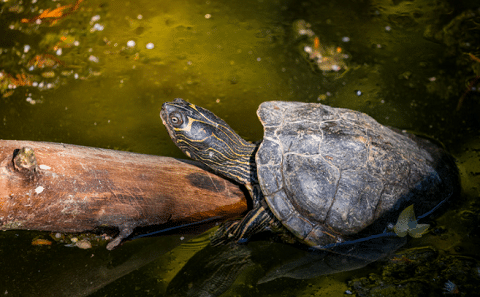
- Scientific Name: Graptemys spp.
- Common Names: Mississippi map turtle, northern map turtle, Ouachita map turtle, false map turtle
- Family: Emydidae
- Origin: North America
- Diet: Omnivore
- Care level: Moderate
- Lifespan: 20 – 30 years
- Temperament: Timid
- Minimum Habitat Size: 3 ft or 75 gallons for males, 5 ft or 125 gallons for females
- Ambient Temperature Range: 80 °F or 27 °C
- Basking Spot: 86 – 90 °F or 30 – 32 °C
- Water Temperature: 72 – 77 °F or 22 – 25 °C
The Mississippi map turtle is a beautiful American species that makes a wonderful pet for more experienced keepers. These stunning reptiles have a unique pattern on their skin and shell that looks like the topographic lines on a map.
Female map turtles grow larger than males, but both need plenty of swimming space and a land portion where they can hang out and bask. This species is easy to feed and will thrive on a diet of turtle pellets supplemented with some meaty insect foods and greens.
6. Painted

- Scientific Name: Chrysemys picta
- Common Names: Painted turtle, Western painted turtle, eastern painted turtle, southern painted turtles
- Family: Emydidae
- Origin: Widespread in North America
- Diet: Omnivorous
- Care level: Easy
- Lifespan: 25 – 50 years
- Temperament: Tame & peaceful
- Minimum Habitat Size: 100 gallons for an adult
- Ambient Temperature Range: 80 – 85 °F or 27 – 29 °C
- Basking Spot: 85 – 95 °F or 29 – 35 °C
- Water Temperature: 75 – 80 °F or 24 – 27 °C
Painted Turtles are an excellent choice for beginner turtle keepers, but only if you are ready for a long-term commitment. These colorful pet turtles are active and fascinating to observe if you keep them in a large enough habitat.
The painted turtle is a great species for keepers who want to keep more than one turtle because they are so peaceful with other species.
7. Snapping

- Scientific Name: Chelydra serpentina
- Common Names: Common snapping turtle
- Family: Chelydridae
- Origin: Widespread in North America
- Diet: Omnivorous
- Care level: Expert
- Lifespan: 30 – 40 years
- Temperament: Aggressive
- Minimum Habitat Size: 120 gallons +
- Ambient Temperature Range: 75 – 85 °F or 24 – 29 °C
- Basking Spot: 90 °F or 32 °C
- Water Temperature: 75 – 78 °F or 24 – 26 °C
Snapping Turtles are amazing creatures with a truly prehistoric look! However, these omnivorous turtles are probably best left in the wild unless you’re an experienced and dedicated reptile keeper.
They might be cute when they are babies, but these reptiles grow huge and quickly outgrow most turtle habitats. Oh, and these turtles can give a nasty bite too!
8. Razor-Backed Musk

- Scientific Name: Sternotherus carinatus
- Common Names: Razor-backed musk turtle, musk turtle
- Family: Kinosternidae
- Origin: Southeastern United States
- Diet: Omnivore
- Care level: Beginner
- Lifespan: 20 – 50 years
- Temperament: Shy
- Minimum Habitat Size: 20 gallons
- Ambient Temperature Range: 75 – 82 °F or 24 – 28 °C
- Basking Spot: 82 – 90 °F or 28 – 32 °C
- Water Temperature: 74 – 79 °F or 23 – 26 °C
The razor-backed musk turtle is an ideal species to keep in a fish tank because it does not need much dry land. However, they will certainly appreciate a warm, dry rock where they can bask and soak up some UVB.
These aquatic turtles spend most of their time down at the bottom and rise to the surface to breathe. They have a deep shell shape, with a distinctive ridge or keel that runs along the top of their carapace.
These small pet turtles grow to just 6 inches, so they are suitable for smaller habitats with good-quality filtration. However, they need plenty of floor space and aquatic plants to really feel at home.
9. Reeves
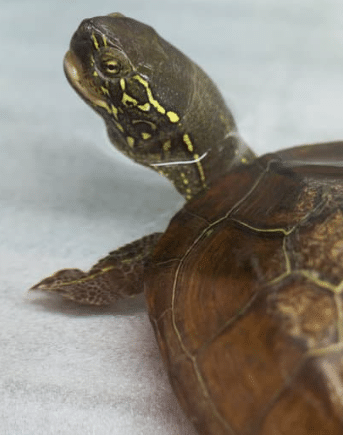
- Scientific Name: Mauremys reevesii
- Common Names: Reeves turtle, Chinese pond turtle, Chinese three-keeled pond turtle
- Family: Geoemydidae
- Origin: East Asia
- Diet: Omnivorous
- Care level: Easy
- Lifespan: 10 – 20 years
- Temperament: Peaceful, can co-habit
- Minimum Habitat Size: 55 gallons
- Ambient Temperature Range: 75 – 85 °F °C
- Basking Spot: 85 – 95 °F °C
- Water Temperature: 70 – 80 °F or °C
Chinese Pond Turtles, also known as Reeves turtles, are a small species that makes a wonderful pet. This hardy and adaptable turtle can be kept in a variety of turtle tanks, from glass aquariums to plastic containers, both indoors and outdoors.
One of the great benefits of this species is its small adult size. With a maximum length of about 6 inches, most specimens will thrive in a standard 55-gallon aquarium with good filtration and a dry basking spot. Like all freshwater turtles, reeves turtle requires access to UVB light and heat to stay happy and healthy.
10. Stinkpot Musk

- Scientific Name: Sternotherus odoratus
- Common Names: Common musk turtle, stinkpot turtle
- Family: Kinosternidae
- Origin: Southeastern Canada and Eastern USA
- Diet: Mostly carnivorous
- Care level: Moderate
- Lifespan: 30 – 50 years
- Temperament: Semi-aggressive, may bite and scratch
- Minimum Habitat Size: 30 gallons
- Ambient Temperature Range: 83 – 86 °F or 28 – 30°C
- Basking Spot: 90 °F or 32 °C
- Water Temperature: 72 – 78 °F or 22 – 26 °C
The stinkpot musk is one of the smallest turtle species, reaching just four inches in length. A full-grown adult should ideally have at least 40 gallons, although you can house this species in a 20-gallon at first.
This is a highly aquatic species that spends most of its time in the water. However, you should still provide a small basking area in case your pet wants to catch some rays. Stinkpot musk turtles can excrete a nasty scent when handled, although they only do this if they feel threatened.
11. Striped Mud

- Scientific Name: Kinosternon baurii
- Common Names: Striped mud turtle
- Family: Kinosternidae
- Origin: Southeastern United States
- Diet: Omnivorous
- Care level: Moderate
- Lifespan: Up to 50 years
- Temperament: Semi-aggressive, may bite and scratch
- Minimum Habitat Size: 30 gallons
- Ambient Temperature Range: 80 – 85 °F °C
- Basking Spot: 87 – 92 °F °C
- Water Temperature: 75 – 80 °F or 24 – 27 °C
Striped mud turtles are a miniature species with yellow stripes that grow to just four inches or so. These adorable creatures are not the strongest swimmers and prefer to crawl around at the bottom of their tank. However, these tiny also turtles need a decent land section where they can crawl out to bask and warm up.
Striped mud turtles are an excellent choice for keepers who want a fascinating pet that won’t need a big habitat. This makes them a better choice for indoor turtle care than some common species like red-eared sliders, which can grow surprisingly large.
12. Spiny Softshell

- Scientific Name: Apalone spinifera
- Common Names: Spiny Softshell turtle
- Family: Trionychidae
- Origin: United States, Mexico, & Canada
- Diet: Mostly carnivorous
- Care level: Moderate to Advanced
- Lifespan: up to 50 years
- Temperament: Aggressive if handled
- Minimum Habitat Size: 90 gallons for a male only. Females should be kept in ponds
- Ambient Temperature Range: 80 – 85 °F or 27 – 29 °C
- Basking Spot: 85 – 90 °F or 29 – 32 °C
- Water Temperature: 75 °F or 24 °C
The Softshell turtle is a unique aquatic reptile with a flat shell and long, pointed nose. Despite their goofy look, these large turtles can and will bite, so they are not pets that you should handle.
Spiny softshells need loads of swimming space in their turtle tank, and since males stay much smaller, they are the better option for most keepers. These soft shell turtles are only suitable for more experienced turtle keepers.
13. Wood

- Scientific Name: Glyptemys insculpta/ Clemmys insculpta
- Common Names: North American wood turtle
- Family: Emydidae
- Origin: Northeastern United States
- Diet: Omnivorous
- Care level: Easy
- Lifespan: 40 to 58 years
- Temperament: Peaceful & tame
- Minimum Habitat Size: 5 ft x 5ft with 2 ft water depth
- Ambient Temperature Range: 70 – 80 °F or 21 – 27 °C
- Basking Spot: 85 °F or 29 °C
- Water Temperature: 60 – 70 °F or 16 – 21 °C
The wood turtle is an excellent choice for turtle keepers who live in cooler areas because this species needs cool water between 60 and 70 degrees Fahrenheit to survive.
This medium-sized turtle can reach about 9 inches, so they need plenty of swimming space. An outdoor enclosure is usually the best choice, but only if you live in a cool climate. North American wood turtles are an endangered species, so insist on keeping captive-bred specimens that are legally sold.
14. Spotted
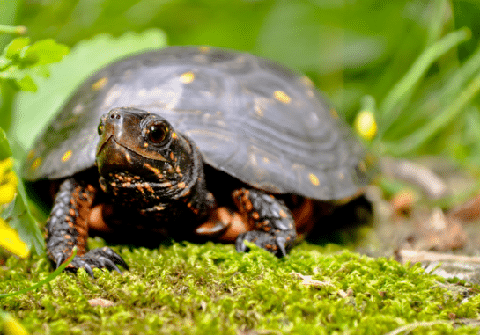
- Scientific Name: Clemmys guttata
- Common Names: Spotted turtle
- Family: Emydidiae
- Origin: Eastern United States
- Diet: Omnivorous
- Care level: Moderate
- Lifespan: 30 – 50 years
- Temperament: Active but shy
- Minimum Habitat Size: 50 gallons
- Ambient Temperature Range: 80 – 85 °F or 27 – 29 °C
- Basking Spot: 95 °F or 35 °C
- Water Temperature: 70 – 75 °F or 21 – 24 °C
The spotted turtle is one of the most beautiful species, which explains its great popularity among reptile keepers. With a maximum size of just 5 inches, they are also a great option for medium to large fish tanks.
Unfortunately, spotted turtles have become an endangered species in the wild, so you should only keep legal, captive-bred specimens or choose one of the other amazing species on this list.
15. Snake Necked
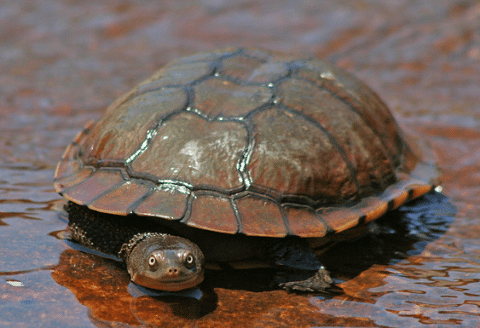
- Scientific Name: Chelodina longicollis
- Common Names: Eastern snake-necked turtle, common snake-necked turtle
- Family: Chelidae
- Origin: Eastern Australia
- Diet: Carnivorous
- Care level: Moderate
- Lifespan: 30 – 40 years
- Temperament: Docile & peaceful
- Minimum Habitat Size: 4ft x 4ft or 150 gallons
- Ambient Temperature Range: 80 – 85 °F or 26 – 29 °C
- Basking Spot: 85 °F or 29 °C
- Water Temperature: 70 – 75 °F or 21 – 24°C
Snake-necked turtles are a fascinating Australian species known for their strange, long necks. These are large and active turtles that can hit shell lengths of 12 inches, so full-grown adults will need a large habitat with plenty of swimming space and a dry spot under a UVB lamp where they can warm up and bask.
Snake-necked turtles are fully carnivorous so feed your pet a commercial pellet food supplemented with meaty foods like insects. These turtles can emit a potent smell to deter predators, but fortunately, they tame up fairly quickly. Nevertheless, these animals should not be handled too often.
Choosing Your Aquatic Turtle
Before buying your first turtle, make sure you have the budget, space, and time available to care for your pet. Most turtles will easily live for over 25 years, making them a life-long pet! You will need to dedicate time to feeding your turtle and cleaning its habitat for all those years too, so buying a turtle is not something you should rush into.
Be sure to study the care needs of your favorite species and start off with an easy species to ensure a fun relationship. It’s also important to consider the conservation status of your pet and avoid keeping wild-caught threatened species. Bear in mind that the legal status of each turtle species differs by state and country.
Choose a healthy specimen from a reliable pet store or reputable breeder that only sells turtles bred in captivity. This will improve your chance of success, reduce the chance of illness, and ensure ethical practices and stamp out illegal poaching.
Creating The Ideal Habitat
Setting up a great turtle habitat from the start is the best way to go. Remember to take your time in planning your turtle tank and always buy the best quality equipment you can afford. Let’s take a closer look at how to create the perfect home for your pet turtle.
Tank Setup
The turtle’s shell length will determine the size and depth of your turtle’s tank. A great rule of thumb is go with a guideline of 10 gallons per inch of the turtle’s body measurement.
The aquarium also needs to be two to two and a half times as deep as the length of your turtle’s shell in order for them to swim and bask comfortably. It’s very important to keep your tank deep enough for the turtle to right itself safely if it gets flipped over.
In nature, turtles climb out of the water to bask in the sun. In captivity, your pet turtle will also need a dry basking spot above the water with a heat and UV light spot. This area should be large enough for the turtle to rest comfortably but can be as small as a single rock for the more aquatic species.
Water Quality And Filtration
Turtles are very messy creatures, so keeping their water clean and safe requires good equipment and some hard work. If you’re using tap water in your turtle habitat, make sure to dechlorinate it with a regular aquarium water conditioner.
A powerful filter is essential for your turtle tank, although the type and size will vary depending on your setup. Canister and internal power filters are both good options, but make sure the model you choose can process the volume of water in your tank at least three times every hour.
Our Subscriber's Choice
Top name brand, Italian made, and updated design. The next gen Fluval Canisters are a best buy!
You’ll also need to perform a weekly water change on your turtle tank to remove the excess waste and improve the general water quality in your tank. A weekly 50% water change is a good starting point, but you may need to perform more frequent maintenance if you notice the water turning cloudy.
Temperature, Basking, And UV Lighting
Aquatic turtles must have basking areas and UV lighting to stay healthy. They need this light to synthesize Vitamin D3, which is essential for bone growth and good health. Without it, they will die a slow and painful death, so please, do not skip this step!
Aquatic turtles need a special UVB (2.5, 3, or 5%) light above their basking spot. It should not be more than 12 inches or 30 centimeters above the ground.
This UVB kit from Zoo Med offers a good value and is perfect for new turtle keepers
Turtles are cold-blooded creatures, so they also need external heat to keep their body temperature in a comfortable range. You will need an aquarium water heater to keep their water warm and a heat lamp to keep the temperature at their preferred range on the basking spot.
While all turtle species are cold-blooded, different types of turtles have different needs. Be sure to set your temperature to suit your pet.
Diet & Feeding Requirements
Feeding your aquatic turtle a healthy and balanced diet is critical for their health and happiness. Provide a well-rounded diet that includes staples, treats, and supplements to ensure that they are getting all of the essential nutrients they need. A varied diet will prevent any health deficiencies while also keeping your beloved pet vibrant and energetic!
Staple Foods
Specially formulated turtle pellets are a great staple diet for your pet. However, you should include natural foods like insects, fish, fruits, and leafy greens for a well-rounded diet. Remember that each species has a slightly different natural diet, so do your research when designing a healthy meal plan.
Mazuri is a brand of food started by Zoo professionals. This gel food is a great food staple for aquatic turtles
Treats And Supplements
Aquatic turtles need various essential nutrients to keep them healthy, and you can provide these using treats as well as supplements.
Fruits such as apple, cantaloupe, bananas, blueberries, and mango are great treats for omnivorous species, while non-toxic aquatic plants like water hyacinth or duckweed can also offer variety. Terrestrial plants like romaine lettuce will work too. Cooked meats like beef and chicken are also great if provided as an occasional treat.
Providing supplements like calcium, Vitamin A, and Vitamin D3, are also helpful, but it’s worth consulting a veterinarian or experienced professional about what dosage suits your particular species.
Feeding Schedule
A regular feeding schedule is recommended for keeping your pet turtle well-fed. Remember, overfeeding can be just as unhealthy as underfeeding in the long run!
Young turtles less than a year old should be fed every day, and you can provide them with as much food as they can eat in about 5 minutes. Older turtles should eat every two or three days, and you can provide about 75% as much food as they can finish in about 15 minutes. Remember to adjust their pellet and portion size as they grow.
Health And Wellness
Preventative Care
Poor water quality, incorrect temperatures, lack of UVB light, and overfeeding are the major causes of poor health in aquatic turtles. If you have set up your turtle tank correctly and are keeping up with regular maintenance and a healthy feeding schedule, all you really need to do is monitor your pet’s health.
Signs Of Illness
The best way to monitor your pet turtle’s health is to observe its condition and behavior on a daily basis. It is important to be aware of any signs that your aquatic turtle may not be feeling their best. Look out for the following ‘red flags’ when observing your turtle:
- Sluggishness
- Lack of appetite
- Difficulty swimming or staying afloat in the water
- A discolored or darkened shell – A evidence of shell rot
- Keratin shedding out of the ordinary pattern
- Bleeding spots on its carapace, with a softer texture, and foul smell
- Respiratory symptoms like struggling to breathe or excessive mucus production from mouth, nose, and eye areas
Contact an experienced exotic pet or reptile veterinarian immediately if you notice any of these symptoms. Be sure to remove your turtle from the water if they are having trouble swimming because turtles can drown. Recognizing these warning signs early on will definitely improve your pet’s chance of survival.
Turtles Vs Tortoises
There is a difference between both of these species, namely that Turtles can go in water, while Tortoises are land based creatures. Tortoises also have more rounded and dome shaped shells, while the turtle’s body is shaped better for swimming. The feet are also difference with Tortoises having stumpy or scaly toes while the turtles have webbed feet or long claws used for swimming.
Turtles are made to be in water while turtles are designed to be in water most of the time.
Legal Considerations And Conservation
It’s important to be aware of the legal matters as well as conservation efforts regarding turtles because many species are threatened by illegal collection, and some can be invasive when released outside of their natural range.
Examples of endangered turtle species include:
- Asian yellow pond turtles
- Spotted turtle
- Wood turtle
Only buy turtles from legal sources, and avoid collecting wild animals or supporting the illegal trade in wildlife. As much as you might want that rare or endangered turtle, these animals are much better off left in the wild!
FAQs
What is the best type of aquatic turtle?
The red-eared slider turtle is one of the most popular choices for its ease of care and amazing looks. These colorful turtles can be kept in a tank of about 60 gallons where they will keep you entertained with their active nature. They are long-lived too, so this is one pet you could call a life-long companion!
Are there any fully aquatic turtles?
The musk turtles of the genus Sternotherus are practically fully aquatic and spend almost all of their time in the water. These tiny turtles grow to just a few inches long, making them a great choice for a fish tank of about 30 gallons.
How long do aquatic turtles live for?
Most captive aquatic turtles have a life expectancy of 20 to 30 years, although some may live for over 50 years with good care! With such an impressive lifespan, it’s important to plan carefully before getting a pet turtle.
What is the ideal tank size for an aquatic turtle?
A 55-gallon tank is a good size for most small to medium-sized aquatic turtles, although some species are more active than others. As a general rule, allow 10 gallons of tank space per inch of your turtle’s shell length.
How often should I change the water in my turtle’s tank?
Change the water in your turtle’s tank at least once a week to keep it healthy and happy. If your turtle’s water is turning cloudy or smelly before the week is up, go ahead and change the water sooner.
Final Thoughts
Turtles are wonderful pets, but they need special care, equipment, and plenty of maintenance. Think carefully before staring out with a turtle, but be prepared for a fascinating and beautiful long-lived companion. This guide is a great starting point, but please research each species carefully before making the commitment, we support happy pets and happy pet owners here at Aquarium Store Depot!
Do you keep freshwater turtles? Tell us about your favorite species in the comments below!
- About the Author
- Latest Posts
I’m thrilled that you found Aquarium Store Depot! Here you’ll find information on fish, aquariums, and all things aquatics related. I’m a hobbyist (being doing this since I was 11) and here to help other hobbyists thrive with their aquariums! I adhere to a high quality Editorial Process and Review products with real life field usage and practical analysis.

